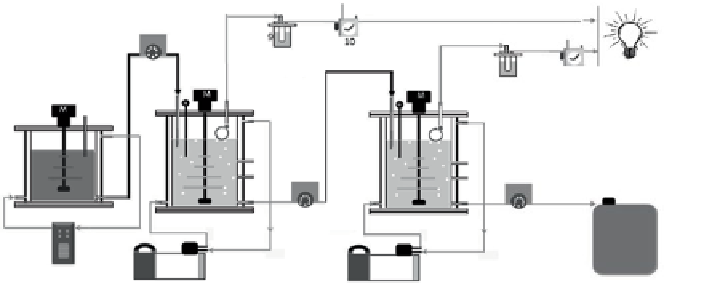Environmental Engineering Reference
In-Depth Information
H
2
H
2
H
2
CH
4
H
2
CH
4
VFAs
CH
4
Fig. 8.20
Schematic diagram of experimental apparatus in the two phase process.
1
Feedstock
tank,
2
Feed inlet,
3
Mixer,
4
Recirculation cooler,
5
Sampling pump,
6
fermentation reactor,
7
Hot water recirculation,
8
Thermometer,
9
Gas-water separation chamber,
10
Wet gas metter,
11
Sample port,
12
Effluent pump,
13
Digestion sludge tank
8.4.8
A Case Study at Tohoku University of Bioenergy
Production from Food Waste by a Two Stage Process
As we have seen above, although methane and hydrogen fermentation are well-
developed technologies, co-production of hydrogen and methane in the course of
anaerobic digestion of organic wastes is at only the early stages of development. We
have thus evaluated production of bio-hydrogen and bio-methane and their relation
to the nature of organic waste materials, using a continuous two-stage thermophilic
fermentation process shown in Fig.
8.20
. Three kinds of actual food wastes were
used, specifically, potato, kitchen garbage and okara (Kobayashi et al.
2012
).
The results show that bio-hydrogen potential not only depends on the carbohy-
drate content but also on the hydrolysis pH of the waste, which is affected by the
nature of the waste materials. Production rates for H
2
and CH
4
were 2.1 and 1.2 l/l/d
for potato; 1.7 and 1.5 l/l/d for kitchen garbage; and 0.4 and 1.4 l/l/d for okara in
the continuous processes. The biogas yields were 20-85 ml H
2
/g VS added and
329-364 ml CH
4
/g VS added, respectively. The H
2
yield increased and the CH
4
yield decreased in the order of potato, kitchen garbage and okara.
Potato and kitchen garbage food waste appear to be more promising for sequen-
tial H
2
and CH
4
production in a two stage fermentation process. On the other hand,
okara food waste might be suitable for a cost-effective CH
4
production process,
owing to there being no need for any pre-treatment. These results can thus inform
selection of the most appropriate anaerobic process, and have shown that a two-
phase process can effectively separate H
2
-producing bacteria from methanogenic
archaea in an economically and technically feasible process, to produce hydrogen
and methane simultaneously from waste.
Further research (Chu et al.
2010
) on the two stage system shows that the
activity of the H
2
-producing bacteria can be effectively separated from that of
methanogenic archaea, which makes a process for producing hydrogen and methane

